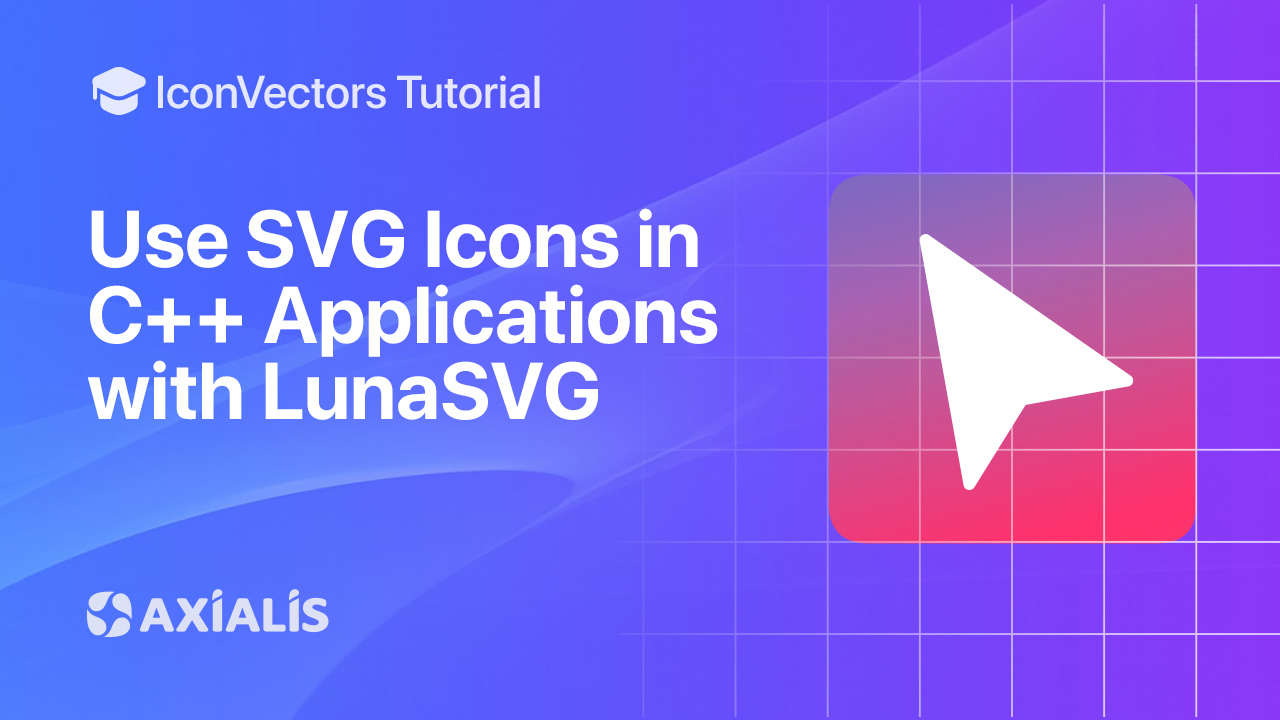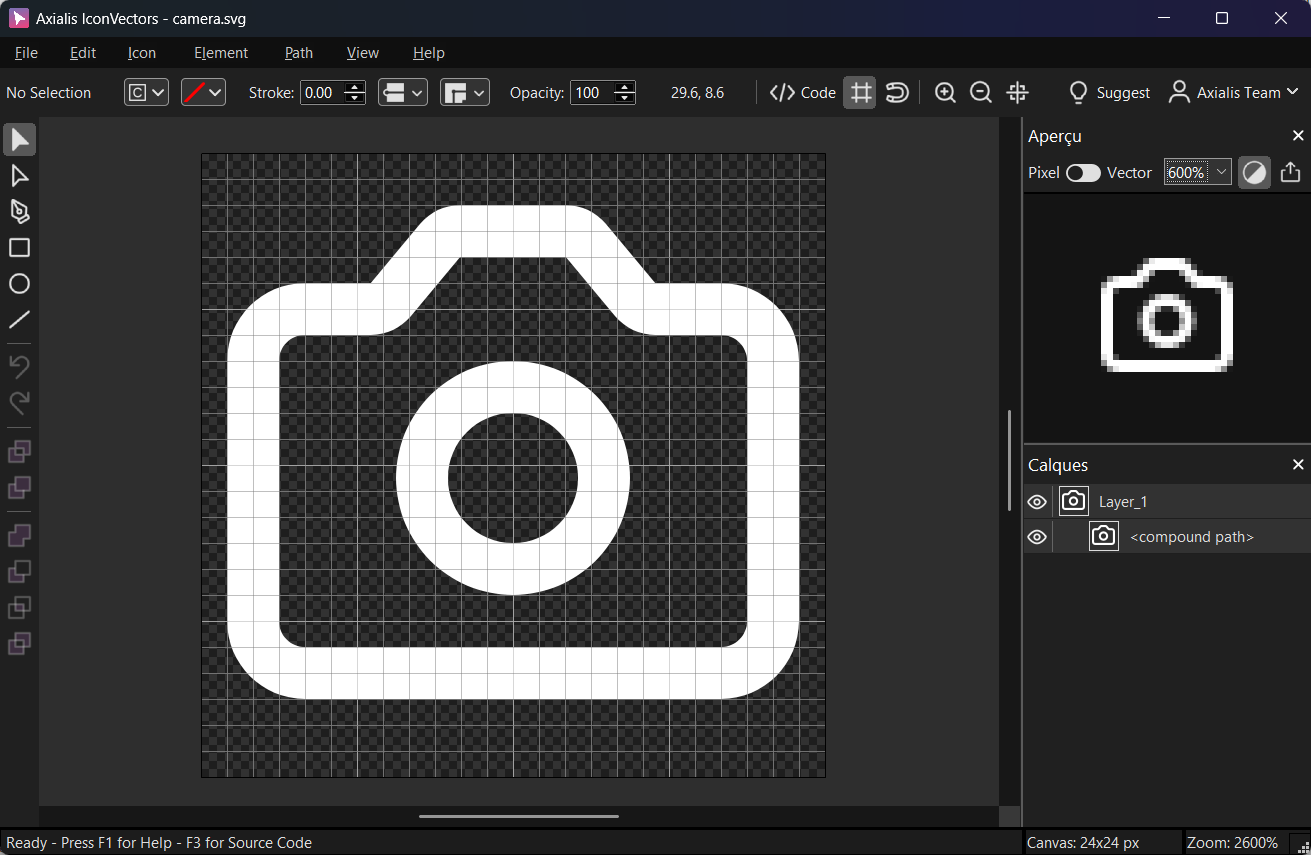Use SVG Icons in C++ Applications with LunaSVG

This guide shows how to import and render SVG icons in C++ using LunaSVG, starting from clean SVGs exported by Axialis IconVectors. You will: render to a Windows HBITMAP using the Windows API, export to PNG cross‑platform, and create a wxBitmap to draw in a wxWidgets app.
Export a clean SVG from IconVectors
- Open or create your icon:
- File → Open… (Ctrl+O) or New Icon (Ctrl+N).
- Prefer a simple, single‑color shape and a clean
viewBox(e.g.,0 0 24 24).

Use File → Export → Export Minified (Shift+Ctrl+M) to get a lean SVG.
Windows: render an SVG to HBITMAP using the Windows API
The snippet below loads an in‑memory SVG string, rasterizes it with LunaSVG, converts the pixels to a top‑down 32‑bpp DIB (HBITMAP), and is ready for AlphaBlend or BitBlt in your UI.
#include <lunasvg.h>
#include <windows.h>
#include <cstdint>
#include <cstring>
#include <iostream>
using namespace lunasvg;
static HBITMAP CreateHBITMAPFromLunaBitmap(const Bitmap& bmp)
{
if (!bmp.valid()) return nullptr;
const int w = bmp.width(), h = bmp.height();
const int srcStride = bmp.stride(); // ARGB premultiplied (A,R,G,B)
const int dstStride = w * 4; // BGRA premultiplied for 32bpp DIB
BITMAPINFO bi{};
bi.bmiHeader.biSize = sizeof(BITMAPINFOHEADER);
bi.bmiHeader.biWidth = w;
bi.bmiHeader.biHeight = -h; // top-down
bi.bmiHeader.biPlanes = 1;
bi.bmiHeader.biBitCount = 32;
bi.bmiHeader.biCompression = BI_RGB;
void* dib = nullptr;
HDC hdc = GetDC(nullptr);
HBITMAP hbmp = CreateDIBSection(hdc, &bi, DIB_RGB_COLORS, &dib, nullptr, 0);
ReleaseDC(nullptr, hdc);
if (!hbmp || !dib) return nullptr;
const uint8_t* src = bmp.data();
uint8_t* dst = static_cast<uint8_t*>(dib);
// Swizzle ARGB (A,R,G,B) → BGRA (B,G,R,A); premultiplication preserved
for (int y = 0; y < h; ++y) {
const uint8_t* srow = src + y * srcStride;
uint8_t* drow = dst + y * dstStride;
for (int x = 0; x < w; ++x) {
const uint8_t A = srow[x*4 + 0];
const uint8_t R = srow[x*4 + 1];
const uint8_t G = srow[x*4 + 2];
const uint8_t B = srow[x*4 + 3];
drow[x*4 + 0] = B;
drow[x*4 + 1] = G;
drow[x*4 + 2] = R;
drow[x*4 + 3] = A;
}
}
return hbmp;
}
// Example SVG (export your own minified XML from IconVectors)
static const char kSVG[] = R"SVG(
<svg xmlns="http://www.w3.org/2000/svg" viewBox="0 0 24 24"><path fill="none"
stroke="currentColor" stroke-width="2" stroke-linecap="round" stroke-linejoin="round"
stroke-miterlimit="10" d="M14.8 3.4l1.9 2.3c.2 .2 .5 .4 .8 .4H20c1.1 0 2 .9 2
2v10c0 1.1-.9 2-2 2H4c-1.1 0-2-.9-2-2V8c0-1.1 .9-2 2-2h2.5c.3 0 .6-.1 .8-.4l1.9-2.3
c.2-.2 .5-.4 .8-.4h4.1C14.3 3 14.6 3.1 14.8 3.4zM8.5 12.5c0 1.9 1.6 3.5 3.5 3.5
s3.5-1.6 3.5-3.5s-1.6-3.5-3.5-3.5S8.5 10.6 8.5 12.5z"/></svg>
)SVG";
int main() {
auto doc = Document::loadFromData(kSVG);
if (!doc) { std::cerr << "Parse error\n"; return 1; }
// Render at document size or pick explicit pixels: renderToBitmap(w, h)
auto bmp = doc->renderToBitmap(24, 24);
if (!bmp.valid()) { std::cerr << "Render error\n"; return 2; }
HBITMAP hbmp = CreateHBITMAPFromLunaBitmap(bmp);
if (!hbmp) { std::cerr << "HBITMAP error\n"; return 3; }
// TODO: Select hbmp into a memory DC and AlphaBlend onto your window DC.
DeleteObject(hbmp);
return 0;
}
Optional: blit with alpha
// After you get HBITMAP hbmp:
HDC hdcScreen = GetDC(hwnd);
HDC hdcMem = CreateCompatibleDC(hdcScreen);
HBITMAP old = (HBITMAP)SelectObject(hdcMem, hbmp);
BLENDFUNCTION bf{};
bf.BlendOp = AC_SRC_OVER;
bf.BlendFlags = 0;
bf.SourceConstantAlpha = 255; // use per-pixel alpha
bf.AlphaFormat = AC_SRC_ALPHA;
AlphaBlend(hdcScreen, dstX, dstY, w, h, hdcMem, 0, 0, w, h, bf);
SelectObject(hdcMem, old);
DeleteDC(hdcMem);
ReleaseDC(hwnd, hdcScreen);
Cross‑platform: import SVG and convert to PNG
Use LunaSVG’s in‑memory API to parse, rasterize, and write a PNG file. This flow is portable and works on Windows, macOS, and Linux.
#include <lunasvg.h>
using namespace lunasvg;
// Your SVG payload (exported & minified in IconVectors)
static const char kSvg[] = R"SVG(
<svg viewBox="0 0 24 24" xmlns="http://www.w3.org/2000/svg">
<path d="M4 12 9 17 20 6" fill="none" stroke="black" stroke-width="2"/>
</svg>
)SVG";
int main()
{
// 1. Parse the SVG straight from the std::string
auto doc = Document::loadFromData(kSvg); // in-memory API
if (!doc) // nullptr -> parse error
return -1;
// 2. Rasterize to an RGBA bitmap (defaults to the SVG’s own width/height)
auto bmp = doc->renderToBitmap();
if (!bmp.valid()) // empty -> render error
return -2;
// 3. Persist the bitmap as a PNG file
// (writeToPng saves the current bitmap buffer to disk)
bmp.writeToPng("output.png");
return 0;
}
Cross‑platform: LunaSVG + wxWidgets (draw a wxBitmap)
This example converts a LunaSVG bitmap to a wxBitmap and draws it in a wxWidgets paint handler. We un‑premultiply the RGB for wxImage and set the alpha channel.
#include <lunasvg.h>
#include <wx/wx.h>
using namespace lunasvg;
static const char kSvg[] = R"SVG(
<svg viewBox="0 0 24 24" xmlns="http://www.w3.org/2000/svg">
<circle cx="12" cy="12" r="8" fill="black"/>
</svg>
)SVG";
static wxBitmap MakeWxBitmapFromLuna(const Bitmap& bmp) {
if (!bmp.valid()) return wxBitmap();
const int w = bmp.width(), h = bmp.height();
const int stride = bmp.stride();
const unsigned char* src = bmp.data(); // ARGB premultiplied
// Allocate RGB buffer (wxImage takes ownership) and separate alpha
unsigned char* rgb = new unsigned char[w*h*3];
unsigned char* alpha = new unsigned char[w*h];
for (int y = 0; y < h; ++y) {
const unsigned char* srow = src + y*stride;
for (int x = 0; x < w; ++x) {
const unsigned char A = srow[x*4 + 0];
const unsigned char Rm = srow[x*4 + 1];
const unsigned char Gm = srow[x*4 + 2];
const unsigned char Bm = srow[x*4 + 3];
// Un‑premultiply: R = Rm*255/A (guard A=0)
unsigned char R = (A ? (unsigned)(Rm*255 + (A/2)) / A : 0);
unsigned char G = (A ? (unsigned)(Gm*255 + (A/2)) / A : 0);
unsigned char B = (A ? (unsigned)(Bm*255 + (A/2)) / A : 0);
const int idx = (y*w + x);
rgb[idx*3 + 0] = R;
rgb[idx*3 + 1] = G;
rgb[idx*3 + 2] = B;
alpha[idx] = A;
}
}
wxImage img(w, h, rgb, /*static_data=*/false);
img.SetAlpha(alpha, /*static_data=*/false);
return wxBitmap(img);
}
class MyApp : public wxApp {
public:
bool OnInit() override {
auto doc = Document::loadFromData(kSvg);
if (!doc) return false;
auto bmp = doc->renderToBitmap(64, 64);
if (!bmp.valid()) return false;
wxBitmap wxbmp = MakeWxBitmapFromLuna(bmp);
auto* frame = new wxFrame(nullptr, wxID_ANY, "LunaSVG + wxWidgets", wxDefaultPosition, wxSize(240,160));
frame->Bind(wxEVT_PAINT, [wxbmp](wxPaintEvent&){
wxPaintDC dc(wxDynamicCast(wxTheApp->GetTopWindow(), wxFrame));
dc.DrawBitmap(wxbmp, 40, 40, /*useMask=*/true);
});
frame->Show();
return true;
}
};
wxIMPLEMENT_APP(MyApp);
Notes & troubleshooting
- Premultiplied alpha — LunaSVG returns ARGB premultiplied pixels. For Windows DIBs, swizzle to BGRA; for wxWidgets, un‑premultiply before setting RGB/alpha.
- Explicit size — pass
renderToBitmap(width, height)if your SVG lacks width/height or to match UI scale. - IconVectors tip — export minified SVG with a clean
viewBox; avoid filters the renderer may not support.
Start Making SVG Icons Today with IconVectors
Download the fully-functional 30‑Day Free Trial and unlock your icon design workflow.
Version 1.10 - September 17, 2025

